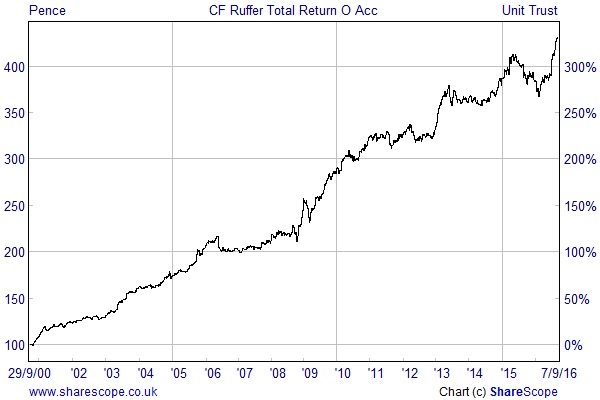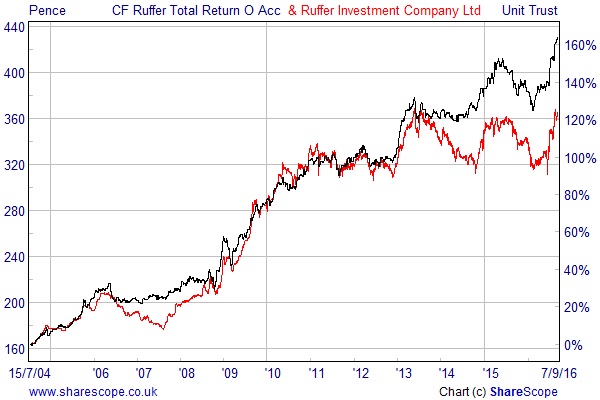Is this fund the ideal inflation hedge?

Last week I wrote about the merits of investing in index-linked gilts as a way of protecting your capital against inflation. There are several specialist funds that operate in this sector, but if you don’t want to get involved in such a niche area you could get a decent exposure via a core portfolio holding like the Ruffer Total Return fund.

The managers, Steve Russell and David Ballance, aim to achieve low volatility, positive returns from an actively managed portfolio of different asset classes, including equities, bonds and currencies. They also have capital preservation high on the agenda.
Their regular fund updates always make interesting reading and August’s is no exception. In their review of the month they point out that the 0.25% cut in interest rates by the Bank of England and the resumption of quantitative easing drove share and bond prices sharply higher, but they then describe it as a phoney war.
A lot of investors seem to have dismissed Brexit as a flash in the pan, whereas in reality it’s going to be a long drawn out process with a lot of uncertainty along the way. Russell and Ballance specifically highlight the recent comments by the US and Japanese governments at the G20 summit in China to show how difficult it will be to retain the all-important market access while delivering on the voters’ demand for greater control on immigration.
Another key factor is the appointment of a new Chancellor of the Exchequer with Philip Hammond taking over from George Osborne. It is likely that his first Budget on November 23 will signal the start of some kind of fiscal expansion to replace the endless austerity followed by his predecessor.
Russell and Ballance think that the change in policy will drive up inflation expectations from their current low levels and they have several long standing positions that should benefit from this scenario. These include a 22% allocation to non-UK index-linked government bonds, 15% in long-dated index-linked gilts, a further 9% in UK index-linked gilts and 6% in gold and gold equities. Together they make up 52% of the portfolio.
The other interesting point they make is that with interest rates at such low levels, loosening monetary policy even further will make very little difference. This could suggest that it is time for the government to reduce real interest rates (by raising inflation) rather than cutting nominal rates closer to zero.
It is hard to believe that markets will come out of this unscathed and we have recently seen a bit of weakness start to creep in. To guard against this the Ruffer portfolio has 3% invested in ‘protective illiquid strategies’ as well as 1% in options and 5% in cash, although we don’t have the details so it’s impossible to tell how much downside protection these positions will provide.
The other 39% of the fund is invested in global stock markets with the biggest geographic allocations being the 15% weighting in Japan and the 11% in the UK.
Solid long-term returns
Ruffer Total Return has delivered solid long-term gains with the accumulation shares up almost 330% since the fund was launched in September 2000. This is well ahead of both the FTSE All-Share and the FTSE Government All-Stocks fixed interest benchmark.
The £3bn fund operates in the Mixed Investment 20% to 60% Shares sector and is a mid-table performer over the last five years with a return of 38.7%. There is a lot of different mandates in this area of the market with some being more aggressive than others, but with Ruffer it is very much a defensive mind-set that is particularly well suited to the current climate.
A less welcome aspect of the fund is that it is only dealt once a week, whereas most of its open-ended counterparts are dealt daily. It is also worth highlighting the higher than normal costs as the ongoing charges are 1.53% and there is an initial charge that is normally discounted to around 0.5%.
If you are unhappy about the cost and the dealing restrictions you might want to consider investing in the Ruffer Investment Company instead. This is an investment trust with a similar portfolio, but with a cheaper total expense ratio of 1.18% and the scope to trade it whenever you want during normal market hours.
The Ruffer Investment Company aims to make a positive total annual return, after all expenses, of at least twice the Bank of England Base Rate by investing mainly in shares and bonds. It is managed by Steve Russell – who also runs Ruffer Total Return – and Hamish Baillie.
It has a very similar portfolio with 22% in non-UK index-linked government bonds, 12% in long-dated index-linked gilts and a further 10% in index-linked gilts. There is also 7% in gold and gold equities, 4% in protective illiquid strategies and 1% in options. The other 44% is invested in equities with the biggest exposure being the 17% in Japan.
The investment trust was launched in July 2004 and has delivered a NAV total return since inception of 178.8%. It has been highly correlated with the Ruffer Total Return fund, but has lagged behind it during the last two or three years.

The Ruffer Total Return fund and the Ruffer Investment Company would both make solid core portfolio holdings and are well positioned to protect the value of your capital against the threat of higher inflation.
Comments (0)